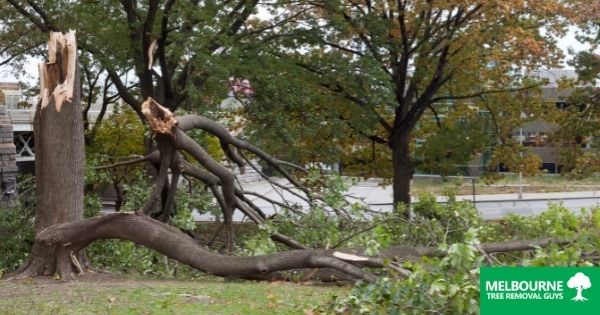We hope that this in depth guide will help you understand exactly what you need to consider to protect yourself in the event that there is tree or branch failure. We also would like to provide you with 6 ways to protect yourself in case of tree branch failure as to give you a well rounded understanding as to what your own situation may be up against.
Codominant stems
If you have a tree with large stems/trunks similar to what is in this first picture then you have what is called a codominant stem. On a mature tree, it is at this point of attachment (or lack thereof) between each stem that increases the likelihood of failure.
Think of it like this. Imagine two separate trees directly side by side to the point of touching. Each year, each tree gets thicker. The thicker each tree gets, the more pressure each tree receives from the other tree. Eventually the smaller tree can’t handle the pressure and cracks along this weak point of connection.
Codominant stem behavior
A codominant stem(s) behaves quite similarly whereby each stem, or in some cases tree trunks, from the same tree grow independently from the adjacent stem. The more the tree grows the more strenuous this point of attachment becomes.
There are measures to alleviate potential strain. The best way is to catch the codominant stem early in life and prune out the smaller stem. In mature trees, a risk analysis should be made to determine if one of the stems should be removed, or perhaps the stems could be cabled, and still in some situations the best option may be to leave the stems.
It is always good to have a certified arborist come out and have a look at the tree to determine the best route forward.
See beside for an example of a mulberry tree that split because of a codominant stem. While it was quite a large failure, thankfully very little got damaged.
Weather (most notably wind and ice)
Think about the force of gravity applied to a tree and the sheer strength required for a tree to fight against that gravity day in and day out.
Most human beings can take a break from gravity and all that precipitates from it such as rain, ice storms, and wind. We can go indoors, sit down and enjoy a nice cup of tea, and afterward when we get real sleepy, we can take a nap or go to sleep. These are some of the ways that we can help cope with gravity and all that it brings. We get breaks.
Trees don’t. Day in and day out they fight gravity. Some days this is more challenging than others. For example, when it rains, trees experience the force of gravity on itself 25% more. Now how much more do you think it might experience gravity if suddenly there is a flash freeze on trees. You know what I am talking about, that situation when the trees look absolutely stunning because they sparkle with radiance. Perhaps they experience gravity twice as much as when it rains, perhaps they experience it at 50% greater than the force of gravity on itself.
Nope try higher.
100% …?
Higher.
Go ahead, guess.
200% … ?
Higher.
800% … ?
Ding, ding, ding. Correct.
Put it this way, if a tree can withstand a flash freeze with 0 branch failure, it may be the last thing to survive Armageddon.
So how does a tree owner know if their tree/branch could fail during a bad winter storm?
That is the million dollar question.
Not even an arborist knows this answer with certainty.
Ways to know if a tree/branch has a high or low risk of failure.
- 1. Tree ID — Start with the basics; what kind of tree do you have? To answer maple isn’t good enough. The exact species is better. Manitoba maple is far less sturdy than a sugar maple.
- 2. Know thy tree — Are there any cracks, fungus, cavities, broken branches, deadwood, included bark, etc.
- 3. Understand risk — For our purposes, if an old tree falls in a remote forest… who cares. Sure the tree may be massive but it is a remote forest therefore no person or property will be injured. Likewise, you may have a tree that looks dangerous but if it is far from where persons or property regularly travel then perhaps there is no risk at all.
Mitigating risk
One way to mitigate risk is to move property that could get damaged. If a play structure is near the tree, can the play structure be moved to further away? A little harder to do in the case of a house.
With the case of a house, the best way to reduce the risk is to prune out hazardous limbs over the house.
Some customers do not like branches overhanging their home, this is understandable but in some cases it may increase damage to their building.
Why? Because be elevating branches 10 – 15 feet above a home it eliminates the buffer if a branch 15 – 50 feet above the home snaps. There now would be fewer branches for the snapped branch to get snagged up on.
If you are concerned about potential hazards come inclement weather, call an arborist to come and have a look.
Melbourne Tree Removal Guys – All Tree Cutting & Other Services. Tree Removal, Stump Grinding, Stump Removal, Tree Trimming, Tree Mulching, Tree Pruning & Emergency Tree Removal Experts In Melbourne!
Click here to read more articles regarding tree removal & related services.
If you are in Waterways and looking for Melbourne Tree Removal Guys, below is the best way to visit us.
Melbourne Tree Removal Guys
26 Fleetwood Dr
Narre Warren VIC 3805
https://treeremoval-melbourne.com.au
*Find us on Google Map


Recent Comments